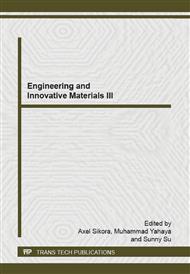p.50
p.57
p.65
p.71
p.76
p.81
p.85
p.91
p.96
Hydrophobic-Synthesis of Bio-Based Epoxy Substrate Using Methyl Ester and its Dust Deposition and Decontamination Effects
Abstract:
This research investigated the prospect of using bio-based substrates for dust decontamination purposes. Initially, bio-based novolac resin was prepared by condensation from the reaction between phenol, bio-oil phenolic fractions and formaldehyde in an acidic medium. The prepared novolac was later transformed to epoxide with epichlorohydrine and 30 percent sodium hydroxide solution. The epoxy formulation was later enhanced with varying amount of methyl ester (10 wt%, 20wt% and 30wt% ). The samples were characterised using various techniques such as FTIR, GC-MS, contact angle etc. Dust depositions and decontaminations tests were also conducted. The results indicated that the synthesized hydrophobic bio-based sample possed some dust cleaning characteristics which when fully enhanced would lead to the emergence of bio-based dust cleaning formulation will contribute immensely in mitigating the negative effect and toxicity of petroleum based products.
Info:
Periodical:
Pages:
76-80
Citation:
Online since:
October 2014
Keywords:
Price:
Сopyright:
© 2014 Trans Tech Publications Ltd. All Rights Reserved
Share:
Citation:


